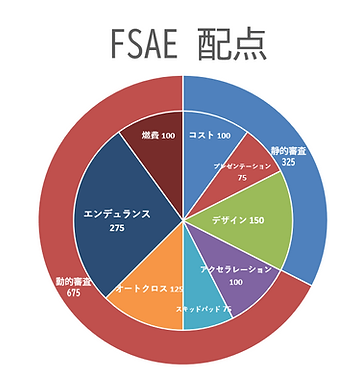What's FSAE?
FSAE was founded in Pontiac, Michigan by the Society of Automotive Engineers to let students get hands-on experience of the automotive world by having them operate a virtual company. FSAE is also an educational event with over 80,000 members from 97 countries worldwide involved in the automotive and aerospace fields.
What started with 6 University teams in 1981, the event welcomed its 35th year in 2015. Japan entered the event in 2000, and more and more teams are joining the event every year. In 2002, 129 teams participated in the event, including Sophia University, Kokushikan University, and Kanagawa University joining the event with their teams.
It originally started as an all-American event, but slowly expanded around the world. English event and Australian event starting in 2001, 2002 respectively. Japanese FSAE started at Fuji speedway in 2003. Recently there have been events held in Brazil and Italy as FSAE continues to grow globally. It had now become a global event as the Formula-SAE world series. Formula-SAE Japan in 2003 started with 17 teams including the one from Sophia University. In 2006, 50 teams including 3 winning teams from abroad. This created the first international series in Formula-SAE.
Formula-SAE operates teams and creates cars according to the SAE regulations. The regulation keeps the freedom of design high while making strict regulations to keep the safety of the sport high. For example, the main goal of the sport is 'to create a racing car that can be sold to amateur racers'. So the car should meet two criterias.
-A car that is easy to accelerate, brake, and turn.
-A car that is easy to ride, and is using parts that are safe and easy to obtain.
The students are supposed to create and manage the racing machine and the team, so involvement in any administrative or design work is prohibited. This paves the way for students
to get first-hand experiences, and the sponsors use F-SAE
to find new talents. The Japanese F-SAE began in 2003 expecting
a similar effect, both on the education and the industry fronts.

Competition contents

- CONTEST SCORING SYSTEM-
The full mark for the entire event is 1000, and this is divided into the Static Part which gives out scores as though the machine is a product and the Dynamic Part where the car goes through several tests on a track.
This means that the vehicle cannot be fast but should be built and planned as a product. Also, as the endurance takes up the most points, the car’s reliability may have to be more important than outright spec or speed. To participate in the dynamic part of the event, the vehicle must go through inspection.
- Cost and Manufacturing Event -
This part of the event looks at the cost of manufacturing as well as how well the cost has been calculated. This looks at the proficiency of a manufacturer and manager, not only as an engineer. The cost report and cost cut plans on two given parts are evaluated and scored as a total of 100 points.
For a high score, you not only need a low-cost vehicle, but a thorough understanding of a car to write a cost-cut plan and accurate manufacturing cost.
- Design Event -
This portion of the event looks at the design cues on the outside as well as the car’s concept and technology and checks whether the car matches the requirements posed by the real market. The teams use prepared boards to make a presentation and the points are awarded based on the answers to the questions that the judges ask.
If the team is scored highly, the team proceeds to the finals and gets the design evaluated by the evaluator.
(Score 150)
- Presentation Event -
In this event, each team presents their vehicle to the judges with the intention of putting their machine out on the road. The teams have to present their machine in a market that matches and works with their car’s strong points. The judges grades the presentation on the validity of the given vehicle’s sales in the selected market. The persuasiveness of the presentation is also taken into the scoring.
(Score 75)
- Acceleration Event -
75m track’s run time is used to compare acceleration. The car starts 50cm before the start line, and the time taken to run the entire course is measured.
Each team can have up to two drivers drive in the event with each drive getting two runs for a total of four runs for every team.
(Score 100)
- Skid Pad Event -
The time of one lap on the figure 8 track with a 15.25m diameter is measured. The whole course has a width of 3m and for each flipped cone, a penalty of a quarter of a second is given.
Each team can run 4 times with 2 drivers getting a maximum of two runs. Figure 8 track has to be run both clockwise and anti-clockwise, and the fastest time in each direction is summed up for the final time.
(Score 75)
- Autocross Event -
Each team has to get a fast time on a tight track composed of high-speed straights, corners, 7m radius hairpins, and slaloms.
The time measured here has a direct impact on the pecking order of the endurance race.
(Score 125)
- Endurance and Fuel Economy Event -
The race distance is 22km in total with 2 drives running each half. The average speed is 48~57kph, and the top speed can go up to 105kph.
There are overtaking zones provided on track, and drivers are not allowed to overtake elsewhere.
Safety is of the utmost importance, and you cannot get any score if the car can’t finish the run.
The fuel economy is calculated with the starting fuel load and the remaining fuel at the end of the race.
(Score: Endurance 275+Fuel Economy 100)